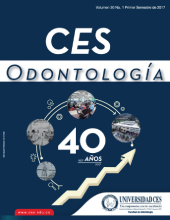El cáncer bucal y su relación con la proteína translocadora mitocondrial de 18kda*
DOI:
https://doi.org/10.21615/cesodon.30.1.2Palabras clave:
Cáncer bucal, proteínas salivales, carcinogénesis, estrés oxidativo (DeCs-bvs)Resumen
El cáncer bucal posee una alta incidencia y mortalidad a nivel global. A pesar de los avances en el diagnóstico y el pronóstico de esta enfermedad, aún se mantiene una baja tasa de supervivencia de 5 años, lo cual hace necesario el estudio de métodos diagnósticos que sean capaces de detectar la enfermedad en estadios tempranos. Es por esto que avances en proteómica e inmunohistoquímica, han permitido identificar diversos biomarcadores, entre ellos la proteína translocadora (TSPO) mitocondrial de 18kDa, la cual está involucrada en diversos procesos celulares, como el transporte de colesterol, la proliferación celular y la apoptosis. Se ha reportado la presencia de valores alterados de la TSPO en diversos tipos de cáncer, así como la presencia de la TSPO en saliva y tejido de sujetos con cáncer bucal, lo cual representa una oportunidad para entender el proceso de la carcinogénesis bucal e identificar nuevas alternativas para el diagnóstico de esta enfermedad. La presente revisión de tema tiene como objetivo presentar aspectos teóricos en relación con la TSPO como un biomarcador a estudiar en sujetos con cáncer bucal, considerando su implicación en los procesos de apoptosis celular y participación en el estrés oxidativo.
Descargas
Referencias bibliográficas
Rettig EM, D’Souza G. Epidemiology of Head and Neck Cancer. Surg Oncol Clin N Am. 2015;24(3):379–396. https://www.ncbi.nlm.nih.gov/pubmed/25979389
Del Corso G, Villa A, Tarsitano A, Gohel A. Current trends in oral cancer: A systematic review. Cancer Cell Microenviron. 2016;3:e1332. http://www.smartscitech.com/index.php/CCM/article/view/1332
Scully C, Bagan J. Oral squamous cell carcinoma overview. Oral Oncol. 2009;45(4):301-308. https://www.ncbi.nlm.nih.gov/pubmed/19249237
Van Zyl AW, Bunn BK. Clinical features of oral cancer: clinical review. S Afr Dent J. 2012;67(10):566-569. https://www.researchgate.net/publication/255984153_Clinical_features_of_oral_cancer
Wall I, Bree RD, Brakenhoff R, Coebergh JW. Early diagnosis in primary oral cancer: is it possible?. Med Oral Patol Oral Cir Bucal. 2011;16(3):300-305. https://www.ncbi.nlm.nih.gov/pubmed/21441877
Bagan J, Sarrion G, Jimenez Y. Oral cancer: clinical features. Oral Oncol. 2010;46(6):414-417. https://www.ncbi.nlm.nih.gov/pubmed/20400366
Fernández A, Córdova P, Badenier O, Esguep A. Epidemiological characterization of oral cancer. Literature review. J Oral Res. 2015;4(2):137-145. http://www.joralres.com/index.php/JOR/article/view/156
Taghavi N, Yazdi I. Prognostic factors of survival rate in oral squamous cell carcinoma: clinical, histologic, genetic and molecular concepts. Arch Iran Med. 2015 ;18(5):314-319. https://www.ncbi.nlm.nih.gov/pubmed/25959914
Johnson NW, Gupta B, Ariyawardana A, Amarasinghe H. Epidemiology and Site-Specific Risk Factors for Oral Cancer. Contemporary Oral Oncology: Springer; 2017. p. 103-153. https://link.springer.com/chapter/10.1007/978-3-319-14911-0_4
Ng JH, Iyer NG, Tan MH, Edgren G. Changing epidemiology of oral squamous cell carcinoma of the tongue: A global study. Head & Neck. 2017;39(2):297-304. https://www.ncbi.nlm.nih.gov/pubmed/27696557
Radoi L, Luce D. A review of risk factors for oral cavity cancer: the importance of a standardized case definition. Community Dent Oral Epidemiol. 2013;41(2):97-109. https://www.ncbi.nlm.nih.gov/pubmed/22882534
Prince VM, Papagerakis S, Prince ME. Oral Cancer and Cancer Stem Cells: Relevance to Oral Cancer Risk Factors, Premalignant Lesions, and Treatment. Curr Oral Health Rep. 2016;3(2):65-73. https://www.infona.pl/resource/bwmeta1.element.springer-doi-10_1007-S40496-016-0081-3
Ernani V, Saba NF. Oral Cavity Cancer: Risk Factors, Pathology, and Management. Oncology. 2015;89(4):187-195. https://www.ncbi.nlm.nih.gov/pubmed/26088938
Vargas-Ferreira F, Nedel F, Etges A, Gomes AP, Furuse C, Tarquinio SB. Etiologic factors associated with oral squamous cell carcinoma in non-smokers and non-alcoholic drinkers: a brief approach. Braz Dent J. 2012;23(5):586-590. https://www.ncbi.nlm.nih.gov/pubmed/23306239
Ford PJ, Farah CS. Early detection and diagnosis of oral cancer: strategies for improvement. J Cancer Policy. 2013;1(1):e2-7. http://www.sciencedirect.com/science/article/pii/S2213538313000039
Iyer S, Thankappan K, Balasubramanian D. Early detection of oral cancers: current status and future prospects. Curr Opin Otolaryngol Head Neck Surg. 2016;24(2):110-114. https://www.ncbi.nlm.nih.gov/pubmed/26963670
Güneri P, Epstein JB. Late stage diagnosis of oral cancer: components and possible solutions. Oral Oncol. 2014;50(12):1131–1136. https://www.ncbi.nlm.nih.gov/pubmed/25255960
Katakura A, Yamamoto N, Sakuma T, Sugahara K, Onda T, Noguchi S, et al. A screening test for oral cancer using saliva samples: Proteomic analysis of biomarkers in whole saliva. J Oral Maxillofac Surg Med Pathol. 2015;27(1):1-5. http://www.sciencedirect.com/science/article/pii/S2212555813000823
Javaid MA, Ahmed AS, Durand R, Tran SD. Saliva as a diagnostic tool for oral and systemic diseases. J Oral Biol Craniofac Res. 2016;6(1):67-76. https://www.ncbi.nlm.nih.gov/pubmed/26937373
Cheng YS. Rees T, Wright J. A review of research on salivary biomarkers for oral cancer detection. Clin Transl Med. 2014;3(1):3. https://www.ncbi.nlm.nih.gov/pubmed/24564868
Yakob M, Fuentes L, Wang MB, Abemayor E, Wong DT. Salivary biomarkers for detection of oral squamous cell carcinoma - current state and recent advances. Curr Oral Health Rep. 2014;1(2):133-141. https://www.ncbi.nlm.nih.gov/pubmed/24883261
Radhika T, Jeddy N, Nithya S, Muthumeenakshi RM. Salivary biomarkers in oral squamous cell carcinoma - An insight. J Oral Biol Craniofac Res. 2016;6(1):S51-S54. https://www.ncbi.nlm.nih.gov/pmc/articles/PMC5122805/
Panta P, Venna VR. Salivary RNA Signatures in Oral Cancer Detection. Anal Cell Pathol. 2014; 2014. https://www.ncbi.nlm.nih.gov/pmc/articles/PMC4333915/
Papadopoulos V, Baraldi M, Guilarte TR, Knudsen TB, Lacapere JJ, Lindemann P, et al. Translocator protein (18kDa): new nomenclature for the peripheral-type benzodiazepine receptor based on its structure and molecular function. Trends Pharmacol Sci. 2006;27(8):402-409. https://www.ncbi.nlm.nih.gov/pubmed/16822554
Papadopoulos V, Lecanu L. Translocator protein (18 kDa) TSPO: an emerging therapeutic target in neurotrauma. Exp Neurol. 2009;219(1):53-57. https://www.ncbi.nlm.nih.gov/pubmed/19409385
Chen MK, Guilarte TR. Translocator protein 18 kDa (TSPO): molecular sensor of brain injury and repair. Pharmacol Ther. 2008;118(1):1-17. https://www.ncbi.nlm.nih.gov/pubmed/18374421
Taliani S, Pugliesi I, Da Settimo F. Structural requirements to obtain highly potent and selective 18 kDa Translocator Protein (TSPO) Ligands. Curr Top Med Chem. 2011;11(7):860-886. https://www.ncbi.nlm.nih.gov/pubmed/21291396
Scarf AM, Ittner LM, Kassiou M. The translocator protein (18 kDa): central nervous system disease and drug design. J Med Chem. 2009;52(3):581-592. https://www.ncbi.nlm.nih.gov/pubmed/19133775
Cosenza-Nashat M, Zhao ML, Suh HS, Morgan J, Natividad R, Morgello S, et al. Expression of the translocator protein of 18 kDa by microglia, macrophages and astrocytes based on immunohistochemical localization in abnormal human brain. Neuropathol Appl Neurobiol. 2009;35(3):306-328. https://www.ncbi.nlm.nih.gov/pubmed/19077109
Veenman L, Papadopoulos V, Gavish M. Channel-like functions of the 18-kDa translocator protein (TSPO): regulation of apoptosis and steroidogenesis as part of the host-defense response. Curr Pharm Des. 2007;13(23):2385-2405. https://www.ncbi.nlm.nih.gov/pubmed/17692008
Šileikytė J, Blachly-Dyson E, Sewell R, Carpi A, Menabò R, Di Lisa F, et al. Regulation of the mitochondrial permeability transition pore by the outer membrane does not involve the peripheral benzodiazepine receptor (translocator protein of 18 kDa (TSPO)). JBC. 2014;289(20):13769-13781. https://www.ncbi.nlm.nih.gov/pubmed/24692541
Scarf A, Auman K, Kassiou M. Is there any correlation between binding and functional effects at the translocator protein (TSPO)(18 kDa)?. Curr Mol Med. 2012;12(4):387-397. https://www.researchgate.net/publication/314745716_Is_there_Any_Correlation_Between_Binding_and_Functional_Effects_at_the_Translocator_Protein_TSPO_18_kDa
Fan J, Lindemann P, Feuilloley MG, Papadopoulos V. Structural and functional evolution of the translocator protein (18 kDa). Curr Mol Med. 2012;12(4):369-386. https://www.ncbi.nlm.nih.gov/pubmed/22364126
Campanella M, Turkheimer FE. TSPO: functions and applications of a mitochondrial stress response pathway. Biochem Soc Trans. 2015;43(4):593-594. https://www.ncbi.nlm.nih.gov/pubmed/26551698
Batoko H, Veljanovski V, Jurkiewicz P. Enigmatic Translocator protein (TSPO) and cellular stress regulation. Trends Biochem Sci. 2015;40(9):497-503. https://www.ncbi.nlm.nih.gov/pubmed/26228316
Caballero B, Veenman L, Gavish M. Role of mitochondrial translocator protein (18 kDa) on mitochondrial- related cell death processes. Recent Pat Endocr Metab Immune Drug Discov. 2013;7(2):86-101. https://www.ncbi.nlm.nih.gov/pubmed/23368281
Veenman L, Gavish M. The role of 18 kDa mitochondrial translocator protein (TSPO) in programmed cell death, and effects of steroids on TSPO expression. Curr Mol Med. 2012;12(4):398-412. https://www.ncbi.nlm.nih.gov/pubmed/22348610
Batarseh A, Papadopoulos V. Regulation of translocator protein 18 kDa (TSPO) expression in health and disease states. Mol Cell Endocrinol. 2010;327(1):1-2. https://www.ncbi.nlm.nih.gov/pubmed/20600583
Apel K, Hirt H. Reactive oxygen species: metabolism, oxidative stress, and signal transduction. Annu Rev Plant Biol. 2004;55:373-399. https://www.ncbi.nlm.nih.gov/pubmed/15377225
Wu X, Gallo KA. The 18-kDa translocator protein (TSPO) disrupts mammary epithelial morphogenesis and promotes breast cancer cell migration. PLoS One. 2013;8(8):e71258. https://www.ncbi.nlm.nih.gov/pubmed/23967175
Austin CJ, Kahlert J, Kassiou M, Rendina LM. The translocator protein (TSPO): a novel target for cancer chemotherapy. Int J Biochem Cell Biol. 2013;45(7):1212-1216. https://www.ncbi.nlm.nih.gov/pubmed/23518318
Avezov K, Reznick AZ, Aizenbud D. Oxidative stress in the oral cavity: sources and pathological outcomes. Respir Physiol Neurobiol. 2015;209:91-94. https://www.ncbi.nlm.nih.gov/pubmed/25461624
Choudhari SK, Chaudhary M, Gadbail AR, Sharma A, Tekade S. Oxidative and antioxidative mechanisms in oral cancer and precancer: a review. Oral Oncol. 2014;50(1):10-18. https://www.ncbi.nlm.nih.gov/pubmed/24126222
Wang J, Schipper HM, Velly AM, Mohit S, Gornitsky M. Salivary biomarkers of oxidative stress: A critical review. Free Radic Biol Med. 2015;85:95-104. https://www.ncbi.nlm.nih.gov/pubmed/25889823
Gatliff J, East D, Crosby J, Abeti R, Harvey R, Craigen W, et al. TSPO interacts with VDAC1 and triggers a ROS-mediated inhibition of mitochondrial quality control. Autophagy. 2014;10(12):2279-2296. https://www.ncbi.nlm.nih.gov/pubmed/25470454
Veenman L, Shandalov Y, Gavish M. VDAC activation by the 18 kDa translocator protein (TSPO), implications for apoptosis. J Bioenerg Biomembr. 2008 ;40(3):199-205. https://www.ncbi.nlm.nih.gov/pubmed/18670869
Gatliff J, Campanella M. The 18 kDa translocator protein (TSPO): a new perspective in mitochondrial biology. Curr Mol Med. 2012;12(4):356-368. https://www.ncbi.nlm.nih.gov/pubmed/22364127
Buczko P, Zalewska A, Szarmach I. Saliva and Oxidative Stress In Oral Cavity And In Some Systemic Disorders. J Physiol Pharmacol. 2015;66(1):3-9. https://www.ncbi.nlm.nih.gov/pubmed/25716960
Bahar G, Feinmesser R, Shpitzer T, Popovtzer A, Nagler RM. Salivary analysis in oral cancer patients: DNA and protein oxidation, reactive nitrogen species, and antioxidant profile. Cancer. 2007;109(1):54-59. https://www.ncbi.nlm.nih.gov/pubmed/17099862
Nagler R, Ben-Izhak O, Savulescu D, Krayzler E, Akrish S, Leschiner S, et al. Oral cancer, cigarette smoke and mitochondrial 18kDa translocator protein (TSPO) - In vitro, in vivo, salivary analysis. Biochim Biophys Acta. 2010;1802(5):454-461. https://www.researchgate.net/publication/41087912_Oral_cancer_cigarette_smoke_and_mitochondrial_18kDa_translocator_protein_TSPO_-_In_vitro_in_vivo_salivary_analysis
Gavish A, Krayzler E, Nagler R. Two populations of TSPO binding sites in oral cancer SCC-15 cells. Exp Cell Res. 2017;350(1):279-283. http://europepmc.org/abstract/med/27939322
Nagler R, Savulescu D, Gavish M. Cigarette smoke-induced reduction in binding of the salivary translocator protein is not mediated by free radicals. Biochimie. 2016;121:1-4. https://www.ncbi.nlm.nih.gov/pubmed/26582415
Jiang Q, Yu Y-C, Ding X-J, Luo Y, Ruan H. Bioinformatics Analysis Reveals Significant Genes and Pathways to Targetfor Oral Squamous Cell Carcinoma. Asian Pac J Cancer Prev. 2014;15(5):2273-2278. https://www.ncbi.nlm.nih.gov/pubmed/24716969
Descargas
Publicado
Cómo citar
Número
Sección
Licencia
Derechos de autor 2021 CES Odontología

Esta obra está bajo una licencia internacional Creative Commons Atribución-NoComercial-CompartirIgual 4.0.



